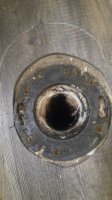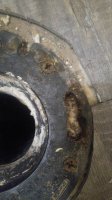Forget the drill business and just take a 3/4" cold chisel and whack the flange from inside to out, right at the outside of the lead but from the inside of the joint.
Then pry the broken flange off and cut the lead into with a wood chisel and pull it out with your channel locks. Should take less than 60 seconds normally.
I see this is a pretty old thread, but not nearly as old as the broken flange in my daughters "new" house. I've removed the broken flange with a couple of whacks on a cold chisel with 2# sledge. It went surprisingly easily. The lead came out in one complete ring, the flange in three pieces. The Big Box Depot says they have no cast iron stuff and didn't seem to have any clue as to "oakum and lead".
The toilet drain pipe goes down into a mostly solid concrete section of the foundation, but around the pipe are large voids and there is no place to mount anykind of expansion insert to secure the flange as you would with wood flooring.
If I can find the correct flange, oakum, and lead I'm not shy about performing the repair, but have a couple of questions not addressed in the early parts of this thread.
1. Will a new cast iron flange with lead seal adequately secure the toilet without being otherwise fixed to the surrounding floor? I wonder if the broken flange was partially due to no other mechanical connection to the floor.
2. How do you secure the flange at the proper level while doing the insertion of oakum and pouring of lead? I saw some pics with thin wood strips supporting a flange. If I use that method I assume I would want to strip the linoleum, press and stick tiles and luan plywood layers that are presently on the concrete. Then once flooring re-done the top surface of the flange would be properly aligned. (level with finished floor surface?)
3. Would it perhaps be wise to fill in the gaps around the drain pipe with stones and concrete and bring the level up to floor level and use the flange I already purchased. I would then use masonry drill to put expansion inserts in the floor to mount the flange securely to prevent movement. The flange I already have reduces the drain to 3" and has a rubber gasket and a ridged pipe the pushes down into the drain pipe to create a seal.
Photo illustrates gap in concrete around flange. Flange pictured is the one mentioned in #3.


